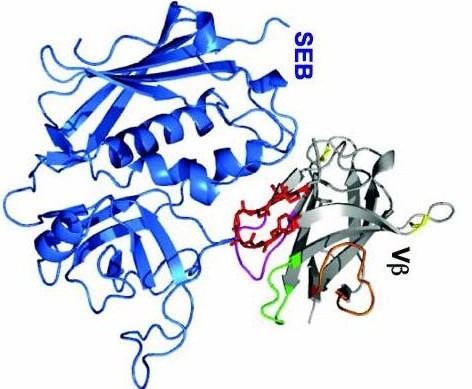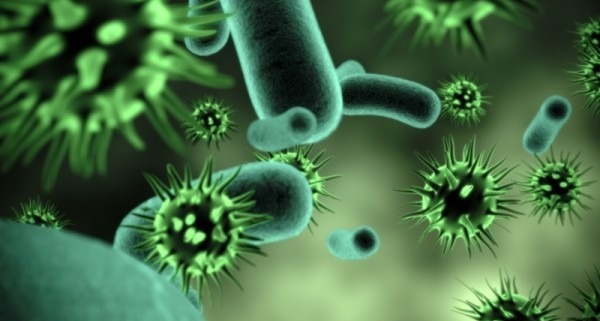Staphylococcal Enterotoxin B (SEB) protein is very potent and very little is required for its toxic effect compared to a synthetic chemical. SEB is very stable and can easily be overproduced, possibly causing system failure and death. Staphylococcus aureus Staphylococcal enterotoxin B (SEB) is a common cause of food poisoning, with severe diarrhea, nausea, and intestinal cramps within hours of ingestion. The toxin is quite persistent and may even be active after the infecting bacteria have been killed. It can withstand boiling at 100°C for several minutes. Like all toxins, SEB is commonly found in nature. Very little is known about how SEB occurs in nature. Some agents have been found in rodents, sheep and cattle. Staphylococcal enterotoxin B (SEB) is the prototype of a potent non-egc-related SAg. This substance is classified as a selective agent because it is the most potent staphylococcal enterotoxin and is much less toxic than synthetic chemicals. In addition, SEB is highly stable and easily produced in large quantities. At low doses, SEB can cause multi-organ system failure and death. Passive immunotherapy using antibodies made in different variants has shown significant efficacy in in vitro studies and reduced lethality caused by staphylococcal rotoxin B in in vivo studies. This should aid future efforts to develop these antibodies as therapeutic agents.
Food poisoning:
SEB is one of the most common toxins involved in foodborne diseases due to its toxin. Typically, food producers heavily contaminate food products with S. aureus through hand contact, coughing, or sneezing. S. aureus grows rapidly and excretes enterotoxins, especially in food products such as cream, mayonnaise, unfrozen meat, dairy and bakery products. Heating contaminated food only kills the bacteria, but the SEB toxin is persistent and does not disappear. After ingestion of the toxin, the incubation period before patients become symptomatic is only about 4 to 6 hours. In one of the countries, a person who was infected with this disease developed conjunctivitis with localized skin swelling within 1 to 6 hours, followed by gastrointestinal symptoms.
Digestive effects:
In the digestive form, the onset of the disease in epidemic mode is usually sudden, which is manifested by increased salivation, nausea, vomiting, and then abdominal cramps and diarrhea, which may also be hemorrhagic. The disease often occurs in all people who have used a common source of contaminated food. can be seen The symptoms of poisoning disappear within 8 hours and recovery is achieved by itself, and no special side effects are mentioned for it.
Respiratory complications:
Inhalation exposure leads to respiratory symptoms such as cough without phlegm, pain behind the sternum, and dyspnea. In the form of inhalation, due to the function of the mucociliary system of the respiratory system, which causes the toxin to be swallowed, digestive symptoms may also be seen at the same time. In the inhalation or respiratory form, the fever may last up to 5 days, with a temperature of 103-106 degrees Fahrenheit, and is usually accompanied by some degree of chills. The cough may persist for up to 4 weeks, and the patient may experience up to 2 weeks of Work and activity become disabled.

Diagnosis:
SEB-mediated poisoning is usually diagnosed based on symptoms. Clinical symptoms of SEB poisoning include fever, vomiting, diarrhea, headache, and in severe cases, fatal shock. Test findings are not specific for the diagnosis of SEB poisoning, as non-specific neutrophilic leukocytosis and high erythrocyte sedimentation rates are present in many diseases. Several methods have been developed to identify and measure SEB in direct years. Immunological methods such as immunodiffusion, radioimmunoassay and ELISA are used to diagnose SEB. The diagnostic form is very similar to influenza, adenoviral, and mycoplasmal viruses, the only difficulty in diagnosis is that the number of people infected with this toxin is large and its duration is very short, which happened 3-12 hours ago.
treatment:
Steroids and antibiotics to treat SEB poisoning. Many water treatment methods for SEB-related diseases have been reviewed and outlined below. They include active immunization with inactivated recombinant SEB vaccines, synthetic peptides, and proteasome-SEB toxoid.
The results of studies and Axon emphasize the humoral immune response and try to produce Abs for passive immunotherapy. It is limited to support and in biological warfare, drug and food administration is great, and in case of a pulmonary edema, ventilation and It is prescribed. Vasopressor and diuretic drugs are needed. Medicines such as acetaminophen and antitussives are also such drugs.
Source: ncbi

Write Your Comment